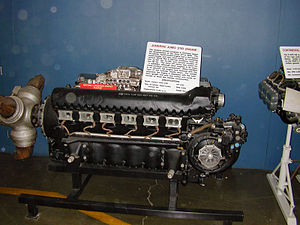Junkers Jumo 211
| Jumo 211 | |
|---|---|
 |
|
| Jumo 211D engine, mounted upside-down in this photo | |
| Type | Piston V-12 aero-engine |
| Manufacturer | Junkers |
| First run | 1936 |
| Major applications |
Junkers Ju 87 Junkers Ju 88 |
| Number built | 68,248 |
The Jumo 211 was an inverted V-12 aircraft engine, Junkers Motoren's primary aircraft engine of World War II. It was the direct competitor to the famous Daimler-Benz DB 601 and closely paralleled its development. While the Daimler-Benz engine was mostly used in single-engined and twin-engined fighters, the Jumo engine was primarily used in bombers such as Junkers' own Ju 87 and Ju 88, and Heinkel's H-series examples of the Heinkel He 111 medium bomber. It was the most-produced German aero engine of the war, with almost 70,000 examples completed.
The Jumo 211 was developed by Dr. Franz Josef Neugebauer as scaled-up successor to the earlier Jumo 210. In 1934, even before the new Jumo 210 had completed its acceptance tests, the RLM sent out a request for a new 1,000 PS-class engine of about 500 kg weight. Both Jumo and Daimler-Benz responded, and in order to reach service before the new Daimler-Benz DB 600, the Jumo team decided to make their new design as similar as possible to their 210H model, currently in testing.
The resulting Jumo 211 was first prototyped at Jumo's Dessau plant in 1935 and started testing in April 1936. Like the 210H, it featured a mechanical direct fuel injection system using small pistons driven off the crankshaft, three valves per cylinder, and an inverted V layout. It also had an open-cycle cooling system, not pressurized, as was the case on the later 213. Limited production of the 1,000 PS (990 hp; 740 kW) Jumo 211A started in April 1937 at Dessau, with just over 1,000 completed before full production was started at Magdeburg in July . Three models were provided with varied settings for its two-speed supercharger, tuned for different low- versus high-altitude performance.
...
Wikipedia
